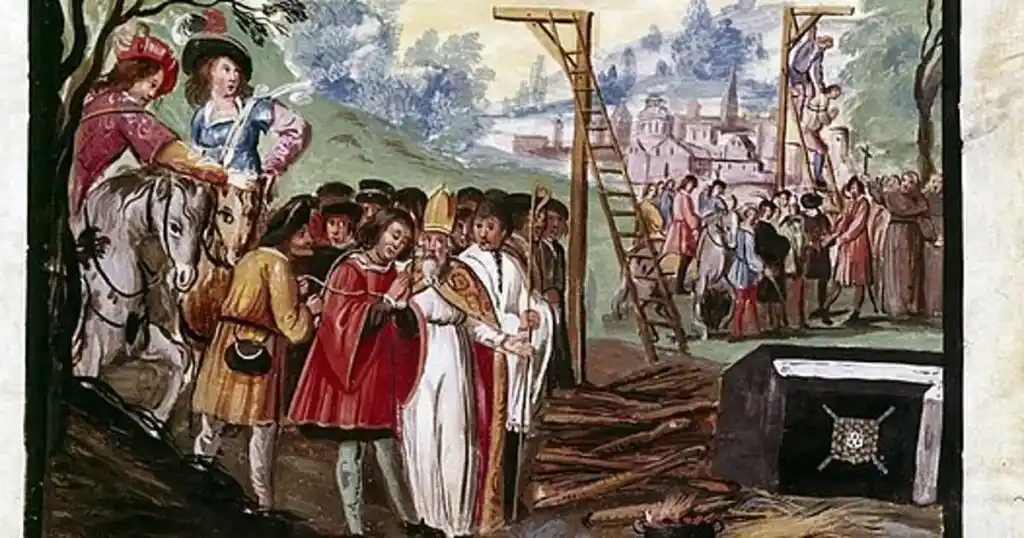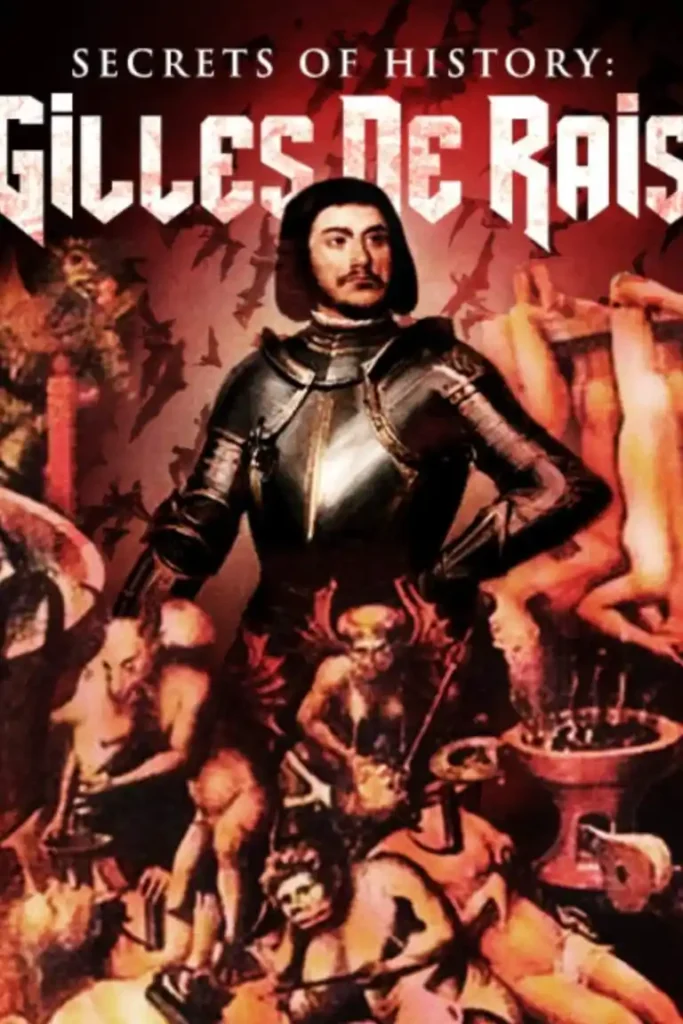Gilles de Rais, once celebrated as a French war hero and a companion of Joan of Arc, is now infamous for his dark and twisted legacy. This article delves into the chilling transformation of a nobleman into one of history’s most notorious serial killers. Discover the grim tale of power, madness, and the haunting crimes that have overshadowed his heroic past.
Table of Contents
The Early Years of Gilles de Rais: A Privileged Upbringing and The Shadow of a Cruel Mentor

Born in 1404 in Champtocé-sur-Loire, France, Gilles de Rais entered the world as a scion of nobility, inheriting vast wealth and a prestigious lineage. His early years were marred by the death of his parents. He was subsequently raised by his maternal grandfather, Jean de Craon, a man notorious for his ruthlessness and Machiavellian tendencies. Jean was a hardened warrior and a master manipulator, known for his cunning political maneuvers and his willingness to resort to violence to achieve his goals. He ruled his domain with an iron fist, instilling fear and obedience in his subjects.
Gilles, a young and impressionable boy, was deeply affected by his grandfather’s cruelty. He witnessed firsthand the brutal punishments meted out to those who dared to cross Jean, the callous disregard for human life, and the relentless pursuit of power at any cost. These experiences warped his moral compass and planted the seeds of a burgeoning darkness within him. Jean’s influence was insidious, gradually eroding Gilles’ sense of empathy and compassion, replacing it with a fascination for power and a thirst for control. The young nobleman began to emulate his grandfather’s behavior, adopting a haughty demeanor and a disdain for those he deemed beneath him.
Jean’s tutelage instilled in Gilles a belief that the world was a cruel and unforgiving place, where strength and ruthlessness were the keys to survival. This toxic worldview, coupled with his own burgeoning sadistic tendencies, created a volatile mix that would eventually erupt in a horrifying display of violence and depravity.
As Gilles entered his teenage years, he began to exhibit a volatile temperament and a penchant for impulsive behavior. His grandfather’s influence, coupled with the absence of parental guidance, fostered a sense of entitlement and a disregard for authority. He became known for his reckless exploits, indulging in extravagant parties and engaging in duels with other young nobles. His rebellious nature and thirst for adventure often led him into trouble, but his wealth and social status shielded him from the consequences of his actions.
Beneath the surface of his privileged existence, a darker side was brewing within him. He developed a morbid fascination with violence and cruelty—often retreating to the solitude of his chambers, poring over gruesome tales of torture and execution. This unhealthy obsession, coupled with his growing sense of alienation and disillusionment with the world around him, laid the groundwork for the monstrous acts that would later define his legacy.
Gilles de Rais: The Blood-Soaked Path to Military Glory
In the year 1429, amidst the tumult of the Hundred Years’ War, a young Gilles embarked on a military career that would cement his reputation as both a valiant warrior and a ruthless butcher. His early exploits on the battlefield were marked by a ferocity that bordered on savagery, as he relished in the chaos of combat and the thrill of inflicting pain upon his enemies.
Gilles quickly rose through the ranks, his tactical acumen and unwavering courage earning him the respect of his peers and the admiration of his superiors. He fought alongside the legendary Joan of Arc, participating in several key battles, including the Siege of Orleans and the Battle of Patay. His battlefield prowess was undeniable, yet his methods were often brutal and excessive, leaving a trail of carnage in his wake.
Tales of his ruthlessness spread throughout the ranks, whispered in hushed tones around campfires. It was said that he took sadistic pleasure in personally executing captured enemy soldiers, often employing gruesome methods such as impalement, dismemberment, and disembowelment.
His cruelty extended beyond the battlefield, as he was rumored to have engaged in acts of wanton violence against civilians, including rape, pillage, and arson. These acts were not merely acts of war, but rather, expressions of a deep-seated cruelty that seemed to derive pleasure from the suffering of others.
His methods were not merely a means to an end, but a source of perverse gratification, a macabre spectacle that fed his insatiable hunger for dominance. The scars of his brutality were etched into the landscape of the Hundred Years’ War, a testament to the depths of his depravity and a grim foreshadowing of the horrors that would later unfold within the walls of his own castle.
The Decline of Gilles de Rais: From War Hero to Occult Obsession
Following his illustrious yet bloody military career, Gilles returned to his ancestral home in 1434, a wealthy and decorated nobleman. He had amassed a vast fortune through inheritance and his military exploits, setting about indulging in a lavish lifestyle that rivaled that of royalty. He commissioned extravagant theatrical productions, built a chapel dedicated to the Holy Innocents, and surrounded himself with a retinue of servants, artists, and scholars.
Eventually, however, Gilles found himself in a precarious financial situation. His vast fortune was rapidly dwindling due to his extravagant lifestyle and reckless spending habits. Moreover, his wartime experiences had left him with a deep-seated trauma, and he sought solace in the occult and the supernatural. The once noble knight became consumed by a dark fascination with alchemy, demonology, and necromancy. He sought out the most disreputable practitioners of the dark arts, inviting them to his castle to perform rituals and incantations, hoping to conjure demons and gain supernatural powers.
His thirst for forbidden knowledge knew no bounds, and he spared no expense in his quest to unlock the secrets of the universe. He spent vast sums of money on rare manuscripts, exotic ingredients, and elaborate ritual implements. His once-grand castle became a den of iniquity, filled with the stench of sulfur and the eerie glow of arcane symbols.
The rituals he participated in became increasingly depraved and violent. He was said to have sacrificed animals, and later children, in his quest to appease demonic entities and gain their favor. Gilles’ obsession with the occult consumed him entirely, twisting his mind and warping his soul—proving to be a financial drain.
He employed a succession of charlatans and con artists who offered him untold riches but delivered nothing but empty promises. He poured vast sums of money maintaining a large household staff, including numerous servants, musicians, and entertainers, all of whom demanded a hefty salary.
In a desperate attempt to maintain his lavish lifestyle, Gilles began selling off his ancestral lands and properties, much to the dismay of his family and advisors. He mortgaged his estates, borrowed heavily from moneylenders, and even pawned his personal belongings, including jewelry and silverware. However, his profligate spending continued unabated, and his debts continued to mount.
By 1435, Gilles was on the verge of financial ruin. His creditors were closing in, his family was disowning him, and his reputation was in tatters. In a desperate bid to salvage his fortune, he turned to increasingly dubious methods, including alchemy, black magic, and even outright fraud. His descent into financial ruin mirrored his moral decline, as he sacrificed his honor and integrity in a futile attempt to maintain his lavish lifestyle.
The Unraveling of Gilles de Rais: From Whispers to Arrest
By 1440, the rumors surrounding Gilles depraved activities had reached a fever pitch. Whispers of missing children, strange rituals, and horrifying screams emanating from his castle had circulated throughout the region for years. However, due to his wealth, power, and influence, few dared to speak out against him openly. The turning point came when Gilles became embroiled in a dispute with the local clergy.
In a fit of rage, he kidnapped a priest, Jean Le Ferron, from a church, thus violating ecclesiastical immunity and incurring the wrath of the Catholic Church. This brazen act provided the impetus for a formal investigation into his activities.
Both the Duke of Brittany and the Bishop of Nantes saw an opportunity to seize his remaining wealth and land holdings. They initiated a joint investigation, gathering evidence from witnesses and conducting searches of his properties. The investigators uncovered a trove of horrifying evidence, including the remains of numerous children, torture devices, and alchemical paraphernalia.
The sheer scale of Gilles’ crimes was staggering, and the public outcry was immense. Faced with mounting evidence and public pressure, the authorities issued an arrest warrant for Gilles and his accomplices. On September 15, 1440, he was apprehended at his castle in Machecoul and taken into custody. His arrest marked the beginning of the end for Gilles as his reign of terror was finally ended.
The Trial of Gilles de Rais: Unveiling the Depths of Depravity
The whispers of Gilles’ atrocities grew into a deafening roar, prompting an investigation by both the secular and ecclesiastical authorities. The trial that ensued was a harrowing affair, revealing the full extent of his depravity and the unimaginable suffering he inflicted upon his victims.
Testimonies from witnesses, including former servants and accomplices, painted a horrifying picture of torture, rape, and murder. Gilles was accused of luring young boys and girls to his castle under false pretenses, where they were subjected to unspeakable acts of cruelty. The victims were often drugged, stripped naked, and then subjected to a litany of horrors, including mutilation, disembowelment, and sexual assault.
The details of the crimes were so shocking and gruesome that many found them difficult to believe. Gilles was accused of taking perverse pleasure in the suffering of his victims, reveling in their screams and pleas for mercy. He was said to have bathed in their blood, performed blasphemous rituals with their remains, and even cannibalized some of his victims.
The evidence against him was overwhelming, and he was ultimately convicted of heresy, sodomy, and the murder of over 140 children. Gilles’ trial was a watershed moment in European history, marking a turning point in the public’s perception of evil. It exposed the dark underbelly of the nobility and revealed the depths of human depravity that could lurk beneath a veneer of wealth and privilege.
1440: The Final Judgment of Gilles de Rais: Execution and Damnation
Following his conviction on October 25, 1440, Gilles de Rais faced a grim fate. The court, recognizing the heinous nature of his crimes, sentenced him to death by hanging and burning. His accomplices, Henriet and Poitou, were also condemned to the same fate.
They were servants of Gilles, playing a chilling role in enabling and participating in their master’s horrific crimes. Initially loyal to Gilles, they eventually succumbed to the pressure of the investigation and confessed their involvement in the atrocities. Their testimonies shed light on the extent of Gilles’ depravity, describing how they assisted him in procuring victims, disposing of bodies, and even participating in the torture and murder themselves.
Henriet and Poitou’s accounts painted a gruesome picture of the goings-on within Gilles’ castles. They described their master’s sadistic pleasure in bathing in the blood of his victims, cutting off their heads, and forcing them to endure unimaginable suffering. The servants’ confessions were crucial in securing Gilles’ conviction and ultimate execution.
On October 26, 1440, a somber procession made its way through the streets of Nantes, carrying the condemned men to their place of execution. A large crowd had gathered to witness the demise of the once-celebrated nobleman who had fallen from grace.
Gilles Knight Killer, dressed in a simple white robe, appeared remorseful and penitent. He confessed his sins publicly, expressing deep regret for the harm he had caused. He asked for forgiveness from God and the families of his victims, hoping to find redemption in his final moments.
The execution was a gruesome spectacle, as the three men were hanged, and their bodies consumed by flames. The stench of burning flesh filled the air, a macabre reminder of the horrors that had transpired within the walls of Gilles’ castle.

His death did not mark the end of his infamy. His name became synonymous with evil, and his story served as a cautionary tale for generations to come. He was remembered as a monstrous predator, a man who had betrayed his noble birth and succumbed to the darkest impulses of the human heart.
“Serial Killers” Stories
- Jack the Ripper: The Enigma of Whitechapel
- Richard Speck: The Chicago Mass Nurse Killer
- Top 20 Serial Killers Zodiac Signs
- Jeffrey Dahmer: The Milwaukee Cannibal
The Bluebeard Connection
The legend of Bluebeard, a wealthy man who murdered his wives, is often linked to Gilles. While there is no direct evidence connecting the two, the similarities in their stories have fueled speculation and contributed to Gilles’ enduring infamy.
Watch “Secrets of History: Gilles de Rais”

Uncover the dark truth behind the Bluebeard legend in this documentary exploring the chilling life of Gilles de Rais, a celebrated French knight with a sinister secret.
Read “The Black Baron: The Strange Life of Gilles De Rais”

Tennille Dix’s 1930 biography, “The Black Baron – The Strange Life of Gilles De Rais,” explores the chilling duality of Gilles de Rais (1405-1440). A celebrated French knight and companion to Joan of Arc, de Rais’ life was a stark contrast of military glory and horrific crimes. Delve into this true crime narrative set in 15th century France, and discover a tale of extravagance, occult fascination, and the sinister acts that led to his downfall. A must-read for anyone intrigued by the darker side of history and the complexities of human nature.
Conclusion: Gilles de Rais’ Depravity
Gilles de Rais remains a complex and controversial figure. His military accomplishments and descent into darkness serve as a stark reminder of the duality of human nature. While his crimes are undeniable, his story continues to captivate and intrigue, prompting reflection on the nature of evil and the potential for darkness to lurk beneath even the most respected facades.
FAQs
Why is Gilles de Rais called the “first serial killer in the world”?
Gilles de Rais is considered the “first serial killer in the world” because he was one of the earliest recorded cases of a person committing a series of murders over an extended period. His crimes shocked France and led to his execution in 1440.
What is the connection between Gilles de Rais and the legend of Bluebeard?
Gilles de Rais is believed to be one of the inspirations for the French folktale of Bluebeard, a wealthy man who murders his wives. The tale parallels the dark and gruesome nature of Rais’s crimes, earning him the nickname “Bluebeard Gilles de Rais.”
What role did “Bluebeard Gilles de Rais” play in the Hundred Years’ War?
Before becoming infamous as the first serial killer in the world, Gilles de Rais was a respected military commander who fought alongside Joan of Arc during the Hundred Years’ War. His military achievements were overshadowed by his later crimes as “Bluebeard Gilles de Rais.”